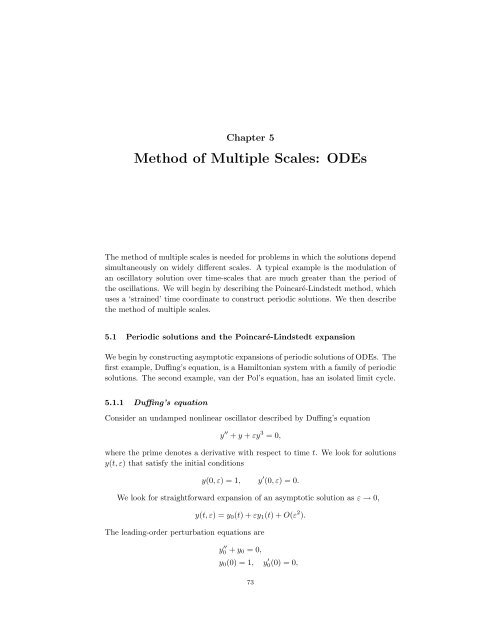Asymptotic Analysis and Singular Perturbation Theory
Asymptotic Analysis and Singular Perturbation Theory
Asymptotic Analysis and Singular Perturbation Theory
You also want an ePaper? Increase the reach of your titles
YUMPU automatically turns print PDFs into web optimized ePapers that Google loves.
Chapter 5<br />
Method of Multiple Scales: ODEs<br />
The method of multiple scales is needed for problems in which the solutions depend<br />
simultaneously on widely different scales. A typical example is the modulation of<br />
an oscillatory solution over time-scales that are much greater than the period of<br />
the oscillations. We will begin by describing the Poincaré-Lindstedt method, which<br />
uses a ‘strained’ time coordinate to construct periodic solutions. We then describe<br />
the method of multiple scales.<br />
5.1 Periodic solutions <strong>and</strong> the Poincaré-Lindstedt expansion<br />
We begin by constructing asymptotic expansions of periodic solutions of ODEs. The<br />
first example, Duffing’s equation, is a Hamiltonian system with a family of periodic<br />
solutions. The second example, van der Pol’s equation, has an isolated limit cycle.<br />
5.1.1 Duffing’s equation<br />
Consider an undamped nonlinear oscillator described by Duffing’s equation<br />
y ′′ + y + εy 3 = 0,<br />
where the prime denotes a derivative with respect to time t. We look for solutions<br />
y(t, ε) that satisfy the initial conditions<br />
y(0, ε) = 1, y ′ (0, ε) = 0.<br />
We look for straightforward expansion of an asymptotic solution as ε → 0,<br />
y(t, ε) = y0(t) + εy1(t) + O(ε 2 ).<br />
The leading-order perturbation equations are<br />
y ′′<br />
0 + y0 = 0,<br />
y0(0) = 1, y ′ 0(0) = 0,<br />
73
















